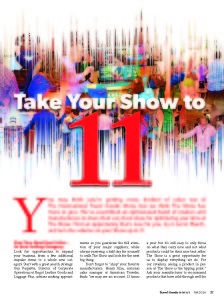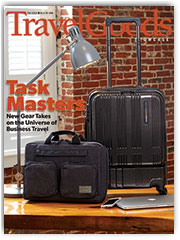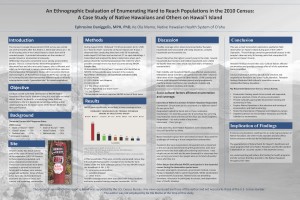
Take Your Show to Eleven
You may think you’re getting every decibel of value out of The Show, but we think The Show has more to give. We’ve assembled an opinionated band of retailers and manufacturers to share their very best ideas for optimizing your time at The Show. Find an opportunity that’s new for you, try it out in March, and turn the volume on your Show up to eleven.
Find Your Next Best Seller…Or Best Selling Category
Look for opportunities to expand your business, from a few additional impulse items to a whole new category. Start with a great search strategy. Guy Paquette, Director of Corporate Operations at Bagot Leather Goods and Luggage Plus, advises making appointments so you guarantee the full attention of your major suppliers, while always reserving a half day for yourself to walk The Show and look for the next big thing.
Don’t forgot to “shop” your favorite manufacturers. Henry Kim, National Sales Manager at American Traveler, finds “we may see an account 12 times a year but it’s still easy to only focus on what they carry now and not what products could be their new best seller. The Show is a great opportunity for us to display everything we do. For our retailers, seeing a product in person at The Show is the tipping point.” Ask your manufacturer to recommend products that have sold-through well for the retailers that have picked them up, but are not yet widely available. A great example is the National Geographic collection from Travelpro, utilizing National Geographic’s extensive library of images. “We use these great images on kid’s luggage, insulated lunch totes, mega totes and in other interesting ways. We have sold these products very effectively with a couple of large retailers,” enthused Scott Applebee, VP of Marketing at Travelpro. “We would like to see other retailers broaden their offering to carry these products. I think they would be very successful.”
Canadian retailers have a secret weapon: handbags. In Canada handbags are traditionally sold in luggage stores. They retail for as much as a piece of luggage, have better margins, take up a fraction of the footprint, and women buy at least one a year. Fashion bags have as many as five seasons a year, freshening the look of the store, and retailers receive a closeout allowance.
If you don’t have the advantage of doing business in Canada you can still move into this lucrative category. You’ll need to commit: offer a selection of brands, research color and style trends, and advertise your new product mix. But the upside is huge. If you want to learn more, noteworthy handbag manufacturers such as Osgoode Marley attend The Show, and suppliers like Boconi also produce beautiful women’s clutches, totes and cross-body bags. Or just find a Canadian and ask them for the inside scoop. That’s what we did. After learning that Paquette wrote a handbag-buying article for the Mode Accessories show, we interviewed him for this piece.
Accessories are the secret to sales growth for many retailers, and like your golf swing, they are something you can always improve. Small personal goods that retail under $40 are a lucrative category with great margins, fast turns and no consumer price-checking. During a luggage purchase “a good rule for your salesperson is sell 10% of the value of luggage in accessories” enthuses Paquette. “I tell them ‘that pays your salary.’ They’ve really gotten the idea. We suggest items like an RFID protection package and luggage locks, money belts, etc.” Paquette recommends accessory suppliers like Lewis N. Clark and Travelon. If you need help keeping on top of all your accessory SKUs, in Canada you can hire Counter Intelligence to take inventory and create fill-in orders.
Don’t forget about leather goods like a wallet or card case, which give consumers a chance to shop for pleasure and buy a small luxury in between the investment purchases of a good suitcase or briefcase. Boconi supplies retailers with a leather wrapped tray to display wallets next to the cash register. “So many men are carrying around ancient and decrepit wallets” explains Bobby Williams, president of Boconi. “When your customer pulls out their broken-down wallet to pay, point out your assortment of trade-up and technical (RFID) wallets on the front counter.”
Colleen Coe, Manager and Buyer at AAA Oregon/Idaho Travel Stores, tiptoed into travel clothing in 2009 and never looked back. “Westarted with UbU jackets. This category did well so in 2011 we brought in a travel vest from SCOTTeVEST. In 2013 we added a travel blazer from Flair Expressions and it has really taken off for us. We don’t have a dressing room so we stick to outerwear & vests. Women are the primary shoppers in this category and they see the value of a stylish, easy-care travel garment.”
And finally, it’s important to remember that you don’t need to bring in a new product assortment to have a new product assortment. Bobby Williams advises: “Carry messenger-style laptop bags? Display them on a waterfall, then on a mannequin, then fanned out on a table. Changing the look of your displays every few weeks allows your customer to discover the merchandise you already have as if it’s brand new.”
Maximize Your Impact
You’re not just searching for inspiration at The Show, you’re bringing inspiration to The Show. Make sure to pack all those brilliant product ideas, sales data, and warranty records. You may be buying for 2015, but it’s time to be thinking about 2016. Here’s how to ask for the product changes you want–and be heard.
First, it’s important to understand the development cycle. In order to cover up-front costs like design, sampling and tooling, most manufacturers need to get at least two years out of a new item. So it may not be possible for a company to take the corrective action you recommend in the first year of a product. But that doesn’t mean they’re not listening. “Once you launch a new line and place the large initial order with the factories, you have already invested quite heavily. Given this, our goal is to try to get retailer and consumer feedback early on in the development process” Scott Applebee explains. “We always have some new products that are in the design phase and we actively seek input from our retailers at The Show, and make changes to these early stage products based on this feedback. We always bring our design and development team to The Show to better understand reaction to our products.”
Expect that the capabilities of each company are different. “Not everyone realizes that American Traveler is very flexible, both in our design/manufacturing resources and our company culture” explains Henry Kim. “It never hurts to ask. We produce a diverse collection of brands, so what you need may already exist in one of our other collections. And if not we want to hear your idea. Product development is much easier if it’s a two-way street. We see progress as incremental, with each new idea opening up a new opportunity.”
Guy Paquette’s strategy to be heard by his manufacturers is a one-two punch of sales…and relationships. “While manufacturers do pay more attention to the product suggestions of their largest volume customers, developing a friendship and keeping in touch goes a long way too.” He wants other retailers to know that it’s possible to get your ideas into production if you are realistic and persistent. “We go to the Samsonite Partnership Conference. I’d been requesting bright yellow and orange suitcases. They wheel out this luggage and announce ‘Guy’s luggage is here!’ We sold through those bags so well we repeated our order several times in the first six months. It’s a great feeling when you know they’re listening.”
Colleen Coe needed a tote with specific features at a certain price point. It took persistence to convince a manufacturer to make it, but when they did it was a big seller and many of their other customers picked it up. “It’s a great feeling when a manufacturer takes your advice. It makes you really feel like you have a stake in the success of the brand.”
Another area where teamwork and communication is essential is when products break. Warranty issues are frustrating because of the nature of retail. When a wheel falls off in the middle of a 3-week trip to Europe, it’s the store manager who has to have an uncomfortable conversation with the consumer, not the designer. Coe explains “it’s good when I hear ‘ok, I’ll send this in to the QC people’ and even better (and much rarer) when you hear back when the problem has been addressed. Give us that extra assurance that you’re learning from the problem.” If you’re not sure that your warranty problems are being heard, bring them up privately at The Show during your scheduled meeting. Make sure to bring warranty reports and photos that show the scope of the problem. Although you may have moments when you believe “that a manufacturer has clearly never used a product before building thousands of them,” as David Stoller, President of Suitcases and More, explained to me in frustration, don’t stop sharing your observations. Bobby Williams acknowledges “some designers don’t want to hear about any changes. My ego’s not in it. I want your ideas and your feedback. All of us working together, that’s what makes this fun.”
Make it Work for You
Manufacturers often have Show programs that can gain you serious margin points on new luggage lines and closeouts. But the programs can be confusing and the terms/payment schedule may not work for your selling season, shipping or tariff costs. If you don’t already belong to a buying group that has pre-negotiated a program, get ready to discuss your buying plan for each vendor and negotiate terms at The Show.
Pre-show, get in a huddle with your bookkeeper, buyer and manager and come up with a cash-flow plan for next year. Then if you are offered 5% 30 net 60 and you need an extra month to pay–or can pay early–negotiate that extra month or discount face to face with the decision maker, not after the fact with the guy two levels below the decision maker.
Don’t forget about shipping, especially if you are on the other side of the country, or the world, from your manufacturer’s warehouse. David Stoller notes “required volume for shipping discounts is just as important as early payment discounts.” It’s possible to negotiate differences for special circumstances, such as higher tariffs and prohibitive shipping costs to your country. “I already have a non-profit” jokes Guy Paquette. “This is a business. You have to develop mutually beneficial relationships, you must be willing to give as much as you take.”
There’s strength in numbers: get involved with the organization specific to your country and work with manufacturers as a group. If one doesn’t exist, do what Guy Paquette did and form your own. (Canadian Luggage & Leathergoods Dealers Association (CLLDA), somewhat like the NLDA in the U.S.)
Remember that as the manufacturer’s business grows with you it will get better. Originally, Briggs and Riley only had a warehouse in California. Now to the relief of their Canadian retailers, they have a warehouse in Vancouver as well.
Crank Up the Volume on your Marketing
Marketing is the most challenging part of being a travel goods retailer. Dial your promotions efforts up to 11 with help from your manufacturers. There may be co-op advertising programs that you don’t know about, or can negotiate for, marketing collateral that is available at no charge, and staff training that will increase your turns for the cost of pizza at the clinic.
Scott Applebee wants you to know that “we have co-op advertising programs that help retailers market our products. Also, Travelpro’s marketing department provides product images, POP, videos, product line ads and banners, and other custom support to our retailers.”
Colleen Coe advises “always ask whether or not co-op dollars are officially available. Most programs are 2-5%. Travelpro’s co-op dollars pay for a half-page ad for us in the AAA VIA Magazine with circulation to over 400,000 households. We’ll also ask our manufacturers for help for packing events. We do workshops at our stores with Anne McAlpin. Three workshops in a weekend recently generated over $21,000 in sales.”
While acknowledging that “vendors have an impossible task of determining what works in some cities, but not in others,” David Stoller gives kudos to Briggs & Riley for their retailer-friendly marketing efforts.
And finally, Guy Paquette reminds us that reps are a great resource for training and tech support. When you meet with your reps at The Show, ask for fitment training for your staff for products like backpacks, raingear, and clothing with internal security pockets. It’s not just retail theatre: employees with technical fitting skills not only add perceived value and make customers feel special, they perform a real service by making sure the customer leaves with the most comfortable and optimally functioning product possible.
We’re Getting the Band Back Together
The most important way you can grow your business at The Show is by renewing relationship with the people you do business with every day. Share a joke, catch up on family news, and celebrate the shared experience of everyone in this big/little business. Developing mutually beneficial business relationships starts with realizing that we’re all in this together, and we’re all here to make things better.
SIDEBAR:
RETAILERS SOUND OFF: What do you wish suppliers knew about exhibiting at The Show?
“Don’t have a closed booth. You miss opportunities and annoy buyers. You are not creating buzz by being mysterious, and it’s doubtful that you are delaying corporate copycats.”
“Don’t pre-qualify the buyer. You can’t know what buying power and influence a person represents by looking at them.”
Guy Paquette, Director of Corporate Operations, Bagot Leather Goods, Luggage Plus
“Especially by the end of the second day, simpler is better. A chair, a bottle of water, and a focused and lively presentation is vital. Our stores sell to a retail customer based on their travel plans and personal style. Do me the same favor, save us both time and focus on the parts of your collection that will work for my business.”
“Fun is a good way to break up The Show appointments. I always enjoy the Eagle Creek Margarita Party & the warm cookies at the TGA lounge, but I think there is a way to do fun without getting in the way of business.”
Colleen Coe, Manager and Buyer, AAA Oregon/Idaho Travel Stores
“Be prepared: have brochures or fliers, along with price lists ready. We don’t want to hear ‘I’ll send it to you.’”
“A lot of stress is visible everywhere. Figure out what you need to do to optimize your booth vibe.”
David Stoller, President, Suitcases & More, Inc.
MANUFACTURERS SOUND OFF: What do you wish retailers knew when attending The Show?
“We’re fortunate because our customers come to The Show with a clear idea of their open to buy, knowing what their holes are and where they need to expand. They know what’s happening in the industry, they’ve done their research beforehand. They’re also upfront, they tell us what won’t work for their customers. It makes our time together very productive.”
Henry Kim, National Sales Manager, American Traveler, Inc.
“From our perspective, it works the best if a retailer schedules an appointment with us prior to The Show. This allows us to prepare, make sure the right people and products are there to facilitate the meeting. We are pleased to say that many of the retailers do schedule an appointment in advance. We certainly encourage and support drop-ins, but knowing in advance helps us meet their needs more effectively.”
Scott Applebee, VP of Marketing, Travelpro International, Inc.
“Retailers should get ‘touchy and feely’ with product. We get so caught up in how a bag looks that we don’t get a feel for the product. If it’s an upright, unzip and zip all zippers. Ask for the bag to be loaded with weight and wheel it around. If it’s a backpack, get the pack on your back and engage the thumb pulls and load lifters. Get to know the function of the product just as well as the form.”
Ronda Wagner, National Sales Manager, Granite Gear LLC.
“To save time, use the Exhibit Hall Floor Plan and book your appointments geographically.”
“Write orders. Going to The Show with a planned budget prepared allows you to make projection commitments while the product is fresh in your mind, which is more productive for all. As a small vendor it is imperative for us to get a read on production to our factories as quickly as possible. If we don’t get orders or at least quantity projections we can’t order raw materials, book production space, and hit delivery dates. This is a team effort. We’re all in this together.”
Bobby Williams, President, r. madison, inc./ BOCONI bags & leather
This article originally appeared in the Fall issue of Travel Goods Showcase.


